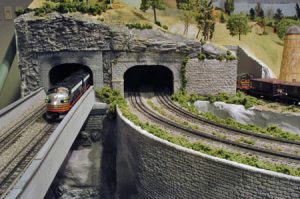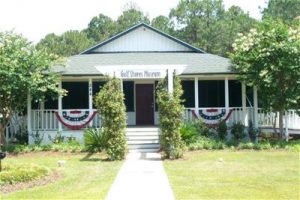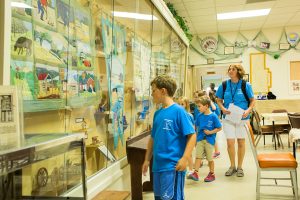 There is so much to see and do along Alabama’s Coastal Connection, from hiking and biking through nature to sitting on the white beaches to fishing our waters. But if you’re looking for a way to mix things up, our museums are the way to go.
There is so much to see and do along Alabama’s Coastal Connection, from hiking and biking through nature to sitting on the white beaches to fishing our waters. But if you’re looking for a way to mix things up, our museums are the way to go.
Whether you’re trying to make the most of a rainy day or you just can’t resist a museum when traveling, the Alabama Coastal Connection is dotted with museums where visitors can learn about the rich history and culture of our state at no cost.
Foley Railroad Museum – Foley’s first railroad depot was built in 1905, and then it was rebuilt in 1908 after a fire burned the original to the ground. The depot and the railroad became the epicenter of the agricultural community of Foley, and during “shipping” season, thousands of boxcars loaded with potatoes, corn, gladiolas and other produce would pull out of the station.
In 1971 following the L & N Railroad discontinuing their services to Foley, the depot building exchanged hands and locations a few times before it was returned to Foley in 1995. At that time, the city decided to turn the depot into the Foley Railroad Museum.
Visit the museum and see photos and artifacts depicting what life was like in South Baldwin County more than 100 years ago. The museum is open Monday through Friday from 10:00 a.m. to 4:00 p.m., and admission is free.
Holmes Medical Museum – Holmes Medical Museum is located in Baldwin County’s first hospital, which was in use from 1936 to 1958. The interior of the museum looks almost exactly as the hospital did when it was in use, and the items on display include medical artifacts like surgical instruments, operating room machinery and a human skeleton. The museum is open Monday through Saturday from 10:00 a.m. to 2:00 p.m.
Gulf Shores Museum – Learn  about how Gulf Shores went from a small fishing village to a tourist destination at the Gulf Shores Museum. Permanent exhibits include “Portrait of a Fishing Village,” which tells the story of the families who settled the area along the north side of Little Lagoon during the 19th century; “Drawing a Line in the Sand,” a commemorative exhibit created to celebrate the city’s 50th anniversary; and “Hurricanes: What you Need to Know,” which teaches guests everything there is to know about these coastal storms. A time capsule from 1976 and an introduction to coastal defenses in the area during WWII make up the rotating exhibits. Admission is free, and the museum is open Tuesday through Friday from 10 a.m. to 12 p.m. and 1 p.m. to 5 p.m. and Saturdays 10 a.m. to 2 p.m.
about how Gulf Shores went from a small fishing village to a tourist destination at the Gulf Shores Museum. Permanent exhibits include “Portrait of a Fishing Village,” which tells the story of the families who settled the area along the north side of Little Lagoon during the 19th century; “Drawing a Line in the Sand,” a commemorative exhibit created to celebrate the city’s 50th anniversary; and “Hurricanes: What you Need to Know,” which teaches guests everything there is to know about these coastal storms. A time capsule from 1976 and an introduction to coastal defenses in the area during WWII make up the rotating exhibits. Admission is free, and the museum is open Tuesday through Friday from 10 a.m. to 12 p.m. and 1 p.m. to 5 p.m. and Saturdays 10 a.m. to 2 p.m.
Orange Beach Indian and Sea Museum – This museum, housed in a 100-year-old former schoolhouse, celebrates Orange Beach’s Native American and fishing heritage. On display are local artifacts, collectibles and memorabilia donated by families of early fishermen that honor the memory of the challenging early days of the area’s fishing industry. The museum is open Tuesday and Thursday from 9:00 a.m. to 4:00 p.m., but group tours can be booked by making a reservation. Admission is free.
 Baldwin County Heritage Museum – See every day artifacts from the daily lives of those who built Baldwin County at the Baldwin County Heritage Museum. Learn all about this agricultural melting pot and the folks who settled there at the turn of the century through the museum’s rotating special exhibits and buildings. The heritage museum is open September 1- May 31, Wednesday through Saturday from
Baldwin County Heritage Museum – See every day artifacts from the daily lives of those who built Baldwin County at the Baldwin County Heritage Museum. Learn all about this agricultural melting pot and the folks who settled there at the turn of the century through the museum’s rotating special exhibits and buildings. The heritage museum is open September 1- May 31, Wednesday through Saturday from
10 a.m. to 3 p.m., and admission is free.
Fairhope Museum of History – Inside a historic 1928 Spanish mission style building that used to serve as City Hall lies the Fairhope Museum of History. The museum’s permanent exhibits tell the story of the city’s unique history and founders, the Single Tax theory, the town jail and the Jubilee phenomenon. Changing exhibits are located in the mezzanine gallery and focus on the Civil War in Baldwin Country, Fairhope’s WWII veterans, Stewart the Picture Man, and more. The museum is open Tuesday through Saturday from 9 a.m. to 5 p.m. with free admission.



Leave A Comment